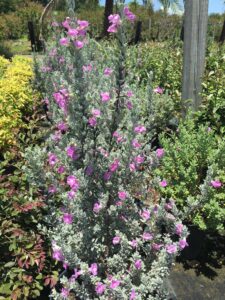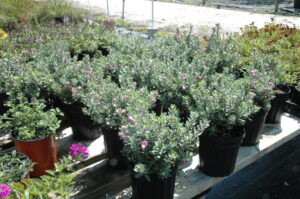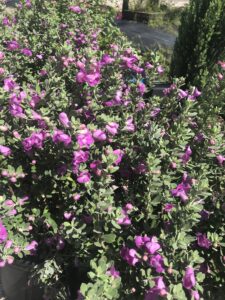S & J Nursery’s Guide to Growing
Texas Sage / Leucophyllum frutescens
in the Northeast Florida Landscape
 Texas sage is one of my favorite landscape plants for the North Florida landscape. It is both an easy care plant selection and a bit picky all at the same time. Mostly due to the fact that these plants thrives on neglect. Give them too much tender loving care and they just go downhill! They are sensitive to over fertilization, do not tend to do well in rich fertile
Texas sage is one of my favorite landscape plants for the North Florida landscape. It is both an easy care plant selection and a bit picky all at the same time. Mostly due to the fact that these plants thrives on neglect. Give them too much tender loving care and they just go downhill! They are sensitive to over fertilization, do not tend to do well in rich fertile
soils that hold moisture, they don’t like allot of water once established and constant shearing can cause the plant to thin out on the interior. Plant it in the right spot and do your best to just leave it alone and you
will love them! I try to think of it as a cactus!
Texas Sage Leucophyllum frutescens Origins:
– Native to the southwest United States.
– Not actually a sage plant, not even in the salvia family, they are a member
of the figwort family so don’t try to chop it up and throw it in the turkey this thanksgiving! Why they are called sage, my guess is the gray green silvery foliage.
Preferred Exposure:
– Plant them in full sun or afternoon sun locations, too much shade can quickly create thin straggly Texas sage plants in the landscape.
Foliage of the Texas Sage / Leucophyllum  frutescens:
frutescens:
– Evergreen foliage can either be green or gray green or even bright silvery gray depending on the selection. Most commonly found cultivars here in Florida are grown for the silver or gray green foliage.
– opposite, simple, evergreen, elliptic to obovate, 1/2-1″, silvery pubescent on
both leaf surfaces.
Soil Preference / Salt tolerance:
– Leucophyllum frutescens is a salt tolerant landscape selection that will need an extremely well drained garden location. They absolutely do not like to be planted into areas where irrigation will consistently be hitting their foliage or where the soil stays moist. Think Cactus!
 Size Variance of the Texas Sage / Leucophyllum frutescens:
Size Variance of the Texas Sage / Leucophyllum frutescens:
– The mature size can range form a more compact selection that is grown to easily stay three or four feet in the garden to larger varieties that will grow up to 6 -8ft if left unpruned. Like the leaf color on the plants being silver on most of the plants you run across, the most commonly found selections
in the Florida garden centers will be a compact grower.
Growth Habit of the Texas Sage / Leucophyllum frutescens in the Northeast Florida
Landscape:
– Narrow upright growing plant when young will broaden into a more rounded habit as it matures.
Growth Rate:
– Slow growing shrub is well worth the effort it takes to find them and select just the right spot in the North Florida landscape.
Bloom:
– Beautiful lavender trumpet or bell shaped blooms emerge close to the foliage during summer and can be up to an inch in diameter.
Water Requirements:
– Texas Sage / Leucophyllum frutescens is extremely drought tolerant once established into the landscape. But be sure to water daily when they are newly planted into the landscape here in the Jacksonville/ St. Augustine
areas of North Florida.
Butterfly or Bird Attracting:
– Attracts butterflies and other pollinators.
Best Uses For Texas Sage / Leucophyllum frutescens:
– Texas Sage make a great choice for an accent shrub or small landscape accent tree. Their dense flower display during summer half of the year make them a showpiece in any landscape setting.
– Perfect for the focal piece of a mixed perennial border when surrounded by lower growing perennial plantings.
– Deer resistant landscape selection
– Great plant for island beds out in the landscape where your grass keeps
dying in those ” hot spots”.
– Texas sage makes an excellent potted plant for a colorful and easy care accent at entry ways, for patio and pool deck planters etc.
– Dried leaves of the Texas sage are used to make an herbal tea that can be
mildly sedative and would make a good bedtime tea and is said to be useful in helping relieve the symptoms of cold or flu. For more information check out the article on leucophyllum frutescens at Foraging Texas.com http://www.foragingtexas.com/2011/12/purple-sage.html
Care of S & J Tree Farm and Nursery’s Texas Sage / Leucophyllum
frutescens:
– Shrubs can be planted in the North Florida | Jacksonville | St.Augustine area at any time during the year. In extremely well draining soils dig the hole as deep as the root ball and two to three times as wide. Plant the top of the root ball level or slightly higher than the surrounding soils. When planting in poorly drained soils,stop and plant them somewhere else!
– Water every day during the establishment period. Avoid heavily
irrigated areas or areas where the irrigation will continuously be hitting the foliage.
– Mulch newly planted shrubs whenever possible.
– Go easy on the fertilizer! These plants have low water and low fertilizer requirements and all that tender loving care will do more harm than good when it comes to Texas sage.
– Prune only as needed. Texas sage does best when left to grow in it’s natural form. Heavy or consistent shearing with hedge clippers will leave
the plant sparsely foliated on the interior. Hand prune in early spring once a year if needed.

